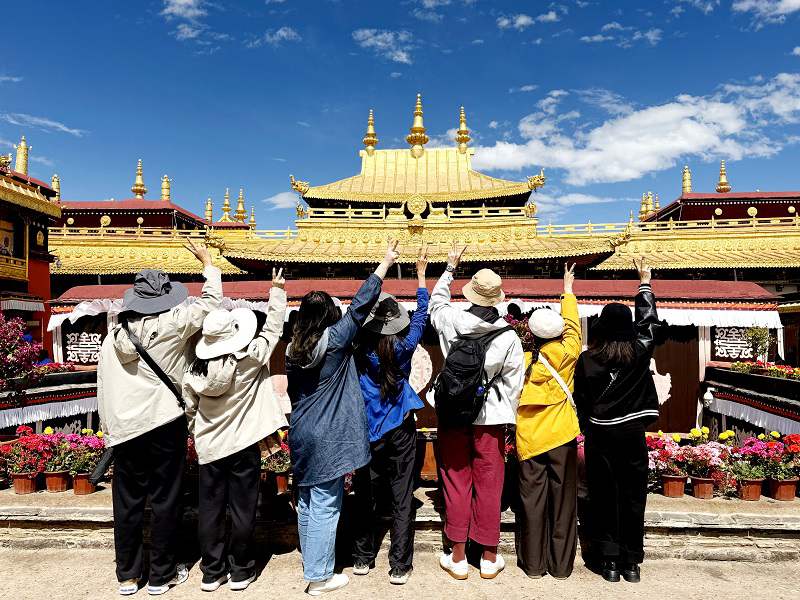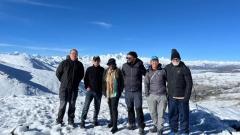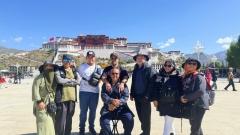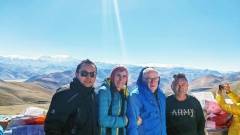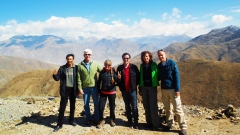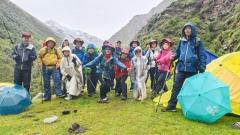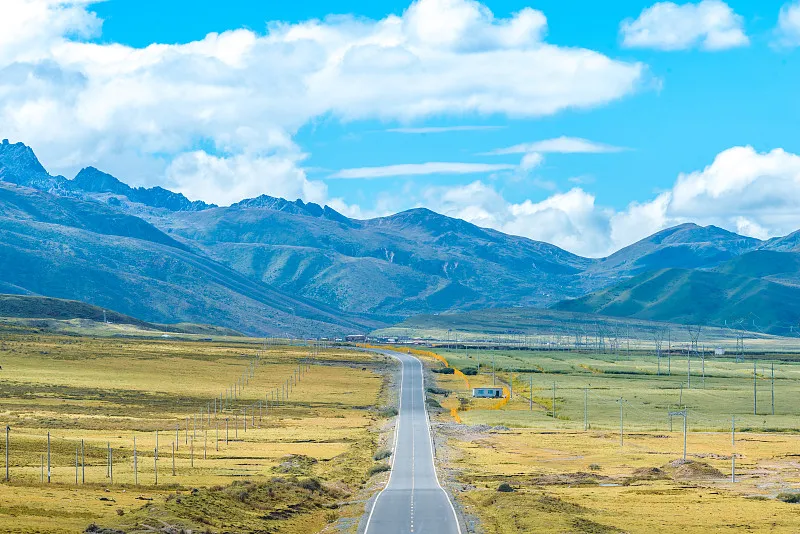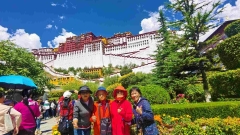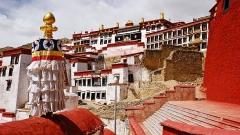Want to know how Tibetans become monks and their daily life in Tibet? Here we will reveal the mysterious life of Tibetan monks. Explore how one becomes a monk in Tibet, the scholastic and daily lives of monks, common personal curiosities about monastic rules, and practical tips for experiencing Tibetan monk life firsthand.
How to Become a Monk in Tibet
Age and Background Requirements
According to Tibetan Buddhist doctrine, candidates must reach seven or eight years old before entering monastic life. This age threshold is traditionally linked to a child’s ability to “drive away crows,” symbolizing a budding independence and readiness for training. Before acceptance, the monastery’s abbot or senior monks will conduct a background check. Professions considered unclean—such as goldsmiths, blacksmiths, butchers, or practitioners of sky burial—may disqualify a candidate. This practice ensures the aspirant approaches monastic life with an unblemished social standing.
Finding Mentors
Once deemed suitable, the young aspirant must secure two teachers:
- Social Conduct Teacher: Usually a relative (uncle, older brother) responsible for guiding behavior, etiquette, and the basics of monastic decorum.
- Spiritual/Academic Teacher: Often another family member or community lama entrusted with introducing the candidate to the rich tapestry of Tibetan Buddhist scriptures.
The Tonsure Ceremony
Prior to official ordination, the child offers a Hada (white ceremonial scarf), yak butter tea, and gifts to their primary teacher. In return, the teacher shaves most of the child’s head, leaving a single tuft of hair as a sign of initial commitment. The head is then presented to the monastery’s abbot. After confirming the child’s genuine desire to join, the abbot completes the tonsure—removing the remaining tuft—and bestows a new Dharma name, signifying rebirth into monastic life.
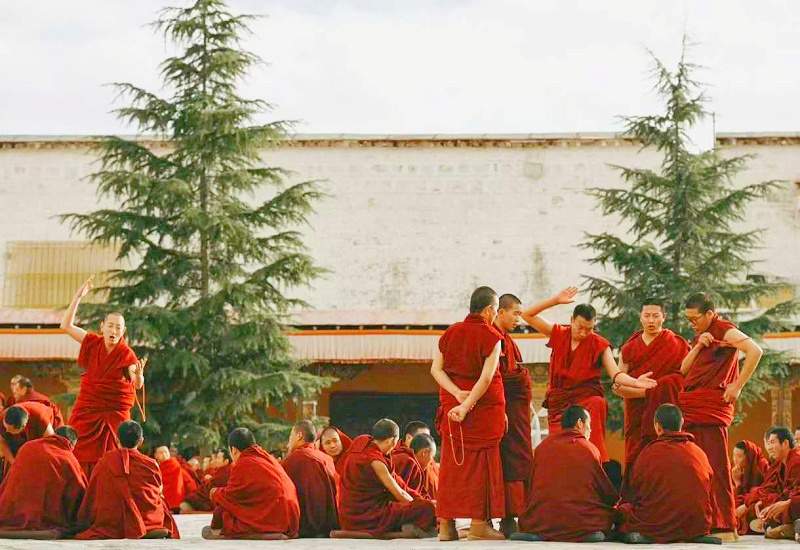
Tibetan Monk
Tibetan Monk Scholastic Life and Curriculum
The First Three Years: Foundations
Newly ordained monks embark on a rigorous three‑year apprenticeship under their mentor, encompassing:
- Monastic Discipline: Learning proper conduct, rituals, and the daily routines of the monastery.
- Chores and Service: Tasks range from kitchen duty to cleaning prayer halls, fostering humility and communal spirit.
- Mantra Spelling & Basic Prayers: Mastery of Tibetan script, basic mantras (e.g., “Om Mani Padme Hum”), and essential prayers.
The Five Great Buddhist Classics
After the initial apprenticeship, monks progress to the Five Classics, each study spanning multiple years:
- Buddhist Logic (Yinming)
- An introduction to Buddhist epistemology and reasoning; typically a three‑year course.
- Heart Sutra (Banruo)
- The core text on “perfection of wisdom,” distilled into a concise yet profound scripture.
- Madhyamika (Zhongguan)
- The study of dependent co‑arising and the Middle Way philosophy.
- Monastic Discipline (Jielv)
- The Vinaya rules governing monastic behavior, ethics, and community life.
- Kusha‑shū (Jushe)
- A treatise on Abhidharma philosophy and the nature of mind.
Monks memorize, recite, and engage in formal debates on these texts—a process that can take 20 years or more to complete. Debates sharpen analytical skills and deepen understanding of Buddhist doctrine.
Modern Daily Life of Tibetan Monks
Dawn Ritual: The Morning Call
As first light breaks, the monk on duty ascends the roof of the Great Assembly Hall, clapping three times to summon blessings from the Goddess of Mercy (Guanyin). At this “morning call,” hundreds of monks stream into the hall for a 2–3 hour prayer session. Visitors may marvel at the solemn rows of chanting monks, as younger novices serve butter tea and porridge, blending nourishment with ritual devotion.
Offerings and Family Prayers
Families often commission monks to chant prayers for health, prosperity, or peaceful passage of loved ones. After the collective prayer, relatives present offerings—typically money or food—to the monks as a sign of gratitude and support.
Midday and Afternoon Sessions
9:00–10:00 AM & 3:00–4:00 PM: Monks gather in smaller chapels such as the Zhacangs Hall or Khangtsen dormitories for shorter afternoon prayers. These sessions reinforce daily discipline and provide additional opportunities for chanting and meditation.
Personal Study and Meditation
Outside formal sessions, monks reserve time for individual meditation, study of commentaries, and practicing ritual arts (e.g., mandala creation, musical accompaniment). This balance of communal and solitary practice underpins their spiritual growth.
Common Questions About Tibetan Monks
Can Tibetan Monks Marry?
No. Following the Buddha’s precepts of celibacy and restraint, Tibetan monks do not marry. Their vows include abstaining from sexual relations to preserve focus on the spiritual path.
Do Monks Drink Alcohol?
Buddha taught that intoxication leads to negligence. Consequently, Tibetan monks avoid alcohol and wine to maintain clarity of mind.
Do Monks Eat Meat?
While strictly vegetarian branches exist, practical allowances permit meat consumption among Tibetan monks. The harsh climate and demanding terrain often necessitate higher‑calorie diets, including meat, for sustenance.
Do Monks Use Smartphones?
Monastic rules vary by tradition, but in most modern Tibetan monasteries, mobile phone use is permitted—though monks are encouraged to balance technology with mindful practice.
Are Monks Paid?
Tibetan monks receive support through:
- Government Stipends: Funds designated for religious scholarship and monastery upkeep.
- Local Donations: Offerings from laypeople for prayers, rituals, and day‑to‑day needs.
Can Monks Leave the Monastery?
Yes. Monks may travel home or explore outside the monastery when their duties are fulfilled. This flexibility strengthens community ties and allows them to participate in family events.
Experiencing Monastic Life: Planning a Tibet Monk Tour
Must‑Visit Monasteries and Temples
- Potala Palace (Lhasa): The former winter residence of the Dalai Lamas, a UNESCO World Heritage site.
- Jokhang Temple (Lhasa): The spiritual heart of Tibetan Buddhism, famed for its golden roof and ancient murals.
- Sera Monastery (Lhasa): Renowned for its daily monk debates in the courtyard, an exhilarating display of logic and ritual.
- Drepung & Ganden Monasteries: Once home to tens of thousands of monks, these expansive complexes offer glimpses into monastic grandeur.
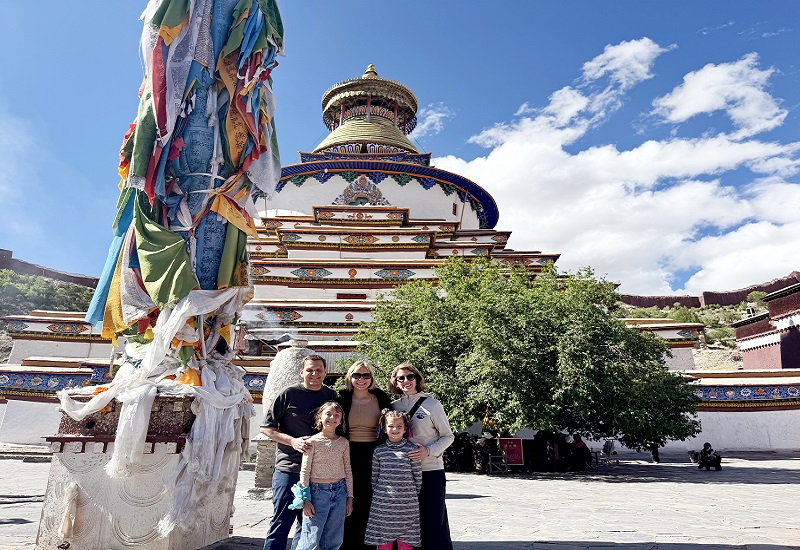
Tibet Temples
Sera Monastery Debates
Held Monday through Saturday, 3:00–5:00 PM, these debates involve standing challengers and seated defenders, clapping their hands to punctuate points. Tourists can observe and even photograph this dynamic exchange, where laughter and dramatic gesture meet profound philosophical inquiry.
Festival Highlights
- Shoton (Yogurt) Festival: Involves unfurling giant Thangka paintings at Drepung and other monasteries—an awe‑inspiring event combining art, ritual, and celebration.
- Losar (Tibetan New Year): A time of feasting, dancing, and special pujas (rituals) that reveal the joyous side of monastic life.
Practical Tips for Travelers
- Dress Respectfully: Cover shoulders and knees; a lightweight scarf can serve as a shawl during temple visits.
- Mindful Photography: Always ask permission before photographing monks, especially during private rituals.
- Altitude Acclimatization: Lhasa sits above 3,600 meters; allow at least two days to adjust before strenuous sightseeing.
- Respect Monastic Etiquette: Keep voices low, remove hats inside temples, and avoid pointing your feet toward altars or statues.
Why Choose China Dragon Travel for Your Tibetan Monk Experience
China Dragon Travel specializes in immersive cultural tours across Tibet. Our Tibetan Monk Immersion Package includes:
- Exclusive Monastery Access: Private visits to monastic debate sessions and behind‑the‑scenes rituals.
- Expert Local Guides: Lhasa‑based scholar‑guides fluent in English and Tibetan, offering insider insights into monastic customs.
- Authentic Homestays: Stay with local Buddhist families to share evening prayers and partake in traditional meals.
- Customized Itineraries: Tailored schedules that balance spiritual experiences with scenic exploration of the Potala Palace, Namtso Lake, and more.
Tibetan monastic life embodies dedication, discipline, and deep spiritual aspiration. For travelers, witnessing dawn prayers, lively monk debates, and ancient festivals offers a rare window into a living tradition. With China Dragon Travel, step beyond the ordinary and discover the sacred rhythms of Tibetan monk life—an unforgettable journey of devotion, culture, and inner transformation.



